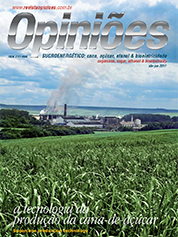Mário Ortiz Gandini
Agroindustrial Director of Usina São Martinho
Op-AA-28
Development and challenges of the mechanical planting of sugarcane
The fact that sugarcane can only be propagated vegetatively confers the planting of this crop distinct characteristics. Ever since plantations began in Brazil, its planting was initially done manually and subsequently aided by mechanical means. For a long time, it was a semi-mechanical procedure, with furrows being opened and closed, along with the mechanical application of inputs and with the harvesting, distribution and cutting of seed cane billets being done manually.
For reasons difficult to explain, mechanical sugarcane harvesting was anticipated in relation to mechanical planting. Due to increased mechanical harvesting, companies were forced to gradually diminish the workforce and to partially or totally adopt this procedure.
Nowadays, there is a difference in terms of technology between harvesting and planting, with a distinct advantage of the former over the latter. During the last fifteen years, harvesting equipment became considerably more modern, field preparation for planting was perfected, and the qualification of people doing the management and operation of a harvest and equipment maintenance improved greatly.
Now the time has come to mechanize planting, which will experience the same learning process and development that harvesting did. Preparing the field, choosing and developing systems and equipment and, essentially, training people involved in the operation, are companies’ objectives at this point in time.
The biggest challenge of mechanical planting begins with the mechanical harvesting of seed cane. Buds, early roots and stalks must be as much integrated as possible. Planting’s final quality is a direct function of the quality of the seed cane.
Initially, all attention was focused on buds, but over time one noticed that with a diminished radicular system, the resistance of recently emerged sprouts is greatly diminished and damages the billets, with infections spreading quickly. Chemical protection of billets against fungi is still not under control.
Planning nurseries must take into consideration the distance to the area to be planted, the variety, its healthiness, and also its age, which may be decisive for the planting’s success. To locate nurseries close to planting areas requires sophisticated planning at least a year ahead of time.
Mechanical MEIOSI (interim method occurring simultaneously) is also a new and excellent option, facilitating supply logistics of planters, while minimizing costs. Starting with good seeds, one must distribute them in such a manner as to obtain a satisfactory end population. Therein lies the second great challenge of mechanical planting.
To decrease damage to billets in the exposure area, one chose 400 mm billets, making their distribution difficult. Because of this unsatisfactory distribution, quantity increases, planter autonomy decreases and the size of nurseries increases. All this results in the increase of operation costs. Large quantities of seedlings per area result in large compartments in the planters, with negative reflexes on the viable operation, on power requirements, radius of gyration and return after rains.
Other factors such as soil preparation, the opening of furrows, the application of fertilizers, pesticides and the covering of billets are equally important, albeit such factors were already viewed as understood, because they were used in manual planting. With the introduction of mechanical planting, special care measures do not end with the closing of furrows.
The sprouting of billets processed in the harvester, in the wagons, and the planter, requires special attention, because surely such billets are less vigorous, less resistant to hydric deficit, and highly sensitive to pesticides, at all times showing evident symptoms of pythotoxicity whenever the application is not done prior to total emerging. One should also point out that the sprouting is more affected due to the occurrence of weeds.
The introduction of the automatic pilot feature added considerable quality to mechanical planting, not only due to the parallelism of rows, but mainly because it facilitates operations in over head maneuvering. In light of the imminent need for introducing mechanical planting, also caused by the expansion of new sugarcane frontiers where manpower is inexistent as the result even of low demographic density, new technologies will have to be introduced more quickly.
Expectations are that one will come up with major changes in terms of developing something like a “sugar-cane seed”, i.e., replacing pieces of stalk that play an important role in protecting the buds and early roots from infections, as a mechanical barrier and a reserve of nutrients, and also as a protection and chemical reserve.
From the moment when one shall have developed mini-billets, with a shape resembling a sphere, apart from diminishing the mass to be transported, their distribution will become much easier. We will then be able to establish, for each variety, in each period, a bud quantity per linear meter and planting will take place as if it were a perfect seeding, with an ideal outcome in terms of population and uniformity.




